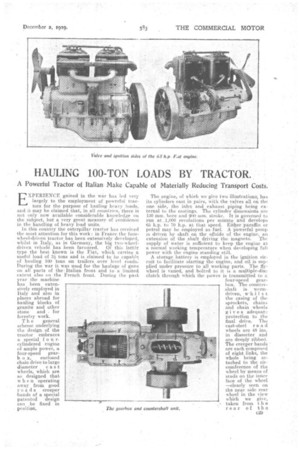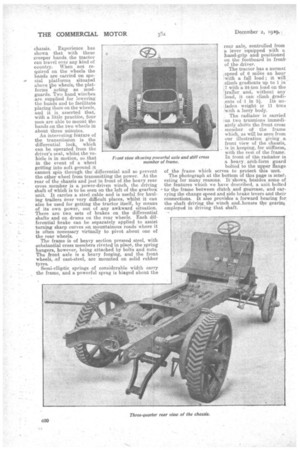HAULING 100-TON LOADS BY TRACTOR.
Page 17

Page 18

If you've noticed an error in this article please click here to report it so we can fix it.
A Powerful Tractor of ItalianMake Capable of Materially Reducing Transport Costs.• F. _JXPERIFNCE gainedin the war has led very largely to the employment of powerful tractors for the purpose of -hauling heavy leads, and it may be claimed that, in all countries, there is not only now available considerable knowledge on the sliblect, but. a very great measure of confidence in the handling of heavy load units.
in this country the caterpillar tractor has received the most attention for this work : in France the fourwheel-driven tractor has been extensively developed, whilst in Italy, as in Germany, the big two-wheel
driven vehicle: has been favoured. Of this latter type the best known is the Fiat, which carries a useful load of I-i: tons and is claimed to be capable: of hauling 100 tons on trailers over level roads., During the war it was used for the haulage of guns on all parts of the' Italian front and to a limited extent also on the. French front. During the past. year the machine
has been extensively employed in Italy and also in places abroad for hauling blocks of granite and ether stone and , for forestry work.
T h e general scheme underlying the design of the tractor embraees a special f o u rcylindered engine of ample power, a four-speed gear
b 0 x,: enclosed chain drive to large diameter cast wheels, which are so designed. that AV h e n operating away from good roads creeper bands of a special patented design can be fixed in position. The engine, of which we givetwo-Illustrations, has its cylinders cast in pairs, with the valVes all on the oneside,: the .inlet and exhaust .piping being external to the castings. The cylinder dimensions are 130 ram, bore and 200 nim: Woke. It. is governed to run at _1,000 revolutions per minute and develops 65 h.p. to 70 h.p. at that speed. Eitheriparaffin or petrol may be employed as.fuel: A-.-powerfulpump is driven by shaft on the offside of the engine, an
extension of the shaft driving the magneto. The silkily of water is sufficient to keep the engine at a normal working temperature when developing full power with the engine standing still.
A storage battery. is employed in the ignition circuit to facilitate starting the engine, and oil is supplied under pressure to all working parts. The flywheel is vaned, and bolted to it Is a multiple-dine clutch through which the power is transmitted to a fourLs.peed gearbox. The counterShaft is wormdriven, wh,i I s t the casing of the sprockets, chains and chain wheels iyes adequate protection to the final drive. The cast-steel road -wheels are 48 ins. in diameter arid are deeply ribbed. The creeper bands -: are each composed of eight links, the whole being attached to the circumference of the wheel by means of studs on the inner face of the wheel clearlyseen on the near side rear wheel in the view which we give, taken from t h e rear of the
chassis. Experience has shown that with these creeper bands, the tractor can travel over any kind of country. When not required on the wheels the bands are carried on special platforms situated above the wheels, the platforms ,acting as mudguards. Two hand winches are supplied for lowering the bands and to facilitate placing them on the wheels, and it is asserted that, • with a little practite, four men are able to mount the bands on the two wheels in about three minutes.
An interesting feature of the transmission is the differential lock, which can be operated from the driver's seat, whilst the vehicle is in motion, so .that in the event of a wheel getting into soft gro-und. it cannot spin through the differential and so prevent the other wheel from transmitting the power. At the rear of the chassis and Justin front of the heavy rear cross member is a power-driven winch, the driving shaft of which is to be seen on the left of the gearbox unit. It carries a steel .cable and is useful for hauling trailers over very difficult places, whilst it can also be used for getting the tractor itself, by means of its own power, out of any awkward situation.
• __ There are two sets of brakes on the differential shafts and on drums on the rear wheels. Each differential brake can be separately applied to assist turning sharp curves on mountainous roads' where it is often necessary virtually to pivot about one of the rear wheels.
The frame is of heavy section pressed steel, with substantial cross members riveted in place, the spring bangers, however, being attached by bolts and nuts. i The front axle s a heavy forging, and the front wheels, of cast-steel, are mounted on solid rubber tyres.
Semi-elliptic springs of considerable width carry the frame, and a powerful sprag is hinged about the
rear axle, controlled from a lever equipped with a /hand-grip and positioned on the footboard in frontof the driver.
The tractor has a normal ,speed of 6 miles an hour with a full load ; it will
;climb gradients up to I. M with a 24-ton load on the trailer and, without any
dead, it can climb kra,cli
„eats of 1 in ai. Its unladen weight is 11 tons with a lorry body.
. The radiator is carried on two trunnions immedi ately above the front cross
member a the frame which, as will be seen from.
our illustration giving a front view of the chassis, is in keeping, for stiffness, with the rest of the 'frame. In front of the radiator is a heavy arch-form guard bolted to the upper flange of the frame which serves to protect this unit. The photograph at the bottom of this page is intei. esting for many reasons. Wallows, besides some of the features which we have described, a unit bolted
tothe frame between clutch and gearcase, and carrying the change speed and side brake levers and their connections. It also provides a forward bearing for the shaft driving the winch and_houses the gearint.” employed in driving that shaft.


























